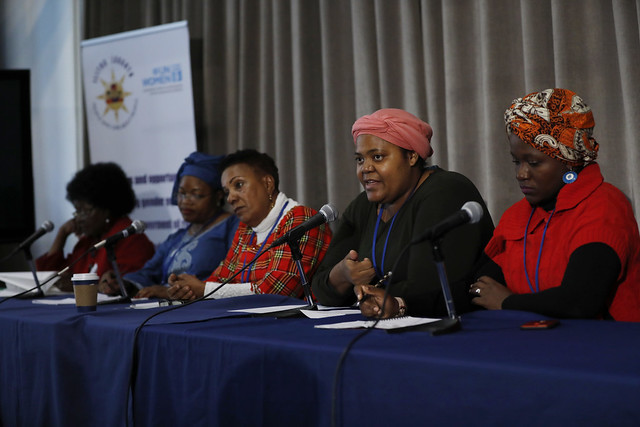5 Encouraging Signs for Women in Zimbabwe
 The magnitude of gender inequality in various African countries is still an ongoing concern. The Republic of Zimbabwe is a promising example of progress. The Zimbabweans’ determination to end the continued inequality in their country encourages many and provides hope for women in Zimbabwe.
The magnitude of gender inequality in various African countries is still an ongoing concern. The Republic of Zimbabwe is a promising example of progress. The Zimbabweans’ determination to end the continued inequality in their country encourages many and provides hope for women in Zimbabwe.
5 Encouraging Signs for Women in Zimbabwe
- Changes in the Zimbabwean Constitution to implement multiple laws on gender equality. After gaining independence from Britain in 1980, the newly formed Republic of Zimbabwe drafted its first constitution. When the constitution began to see disadvantages toward women, it caused not only local but global disapproval. These changes, along with public activism in recent years, show encouraging signs that Zimbabwe is getting closer to gender safety. Women in Zimbabwe became legally protected in having equal status and rights as men 33 years after the original constitution. Zimbabwe’s Bill of Rights states that all “laws, customs, traditions and practices that infringe the rights of women conferred by this constitution are void to the extent of infringement.” In 2015 the government went on to initiate an institutional framework to continue working on women’s rights and gender equality. The Ministry of Women Affairs and Community Development carry out this role. However, steps taken by the nation are still not near full efficiency.
- Despite the late start, a rise of employment for Zimbabwean women shows great success in achieving equal status to men. Zimbabwe ranks number seven out of the 195 countries worldwide in the number of women above the age of 15 holding jobs. In this ranking, Zimbabwe even surpasses first world countries including the United States, France and Canada. Data collected on March 1, 2020, by the International Labor Organization shows women make up 78% of Zimbabwe’s working population. Although this high ratio does leave concern for possible ramifications, the benefits coming from the largely female workforce are showing promising signs of self-sustainment.
- The U.S. and Canada have teamed up with local Zimbabwean groups to become a part of their positive movements. The Embassy of Canada to Zimbabwe promotes Zimbabwe’s projects challenging gender inequality. Canada’s main mission is encouraging male allies to join the women’s rights movement. Canadian Ambassador to Zimbabwe René Cremonese shares the important role men play in challenging social norms by standing in solidarity with women. The U.S. Embassy in Zimbabwe participates in public affairs forums with citizens to provide direction on how the U.S. could support women advocates. For example, in one forum, embassy employees and officials heard from women in Zimbabwe who work in education, health, government, civil society and private sectors about the daily obstacles they face from sexism. These women are setting the bar for women’s involvement in Zimbabwe’s society. The movement is considered to be important to advance U.S. foreign policy.
- There are continuous breakthroughs for women activists thanks to the Women’s Coalition of Zimbabwe (WCoZ), a network of organizations and activists. Women, both independent and members, representing different rights organizations go into specific fields including education, peace-building, constitutional rights and media to improve all sectors of life for women and girls in Zimbabwe. The WCoZ, formed by women in Zimbabwe themselves, has been influential since the congressional reform in 1999. In the 2013 redraft, WCoZ’s work helped achieve the 75% of edits on gender provisions. This victory ensures women’s rights will be protected by the country’s highest level of the law. The WCoZ continuously commits to pressure local governments when gender laws are ignored. The coalition also supports campaigns led by women who lack funding for election compared to their male opponents. Platforms run by the WCoZ that respond to various gender issues continue to be a safe haven for local women to seek support.
- Women in politics are catching on. The minority of women who were able to hold government positions during the first constitutional redraft in 1999-2000 did not successfully pass needed gender provisions. Women who were active in advocacy and lobbying for women’s rights thought it best to form coalitions with movements focused on broader civil society movements. This was not supported by voters due to the women’s movement involvement with government-led committees, which were not trusted at the time. Women activists had to wait nearly 10 years before regaining the opportunity for legal gender protection. This time, during the 2009-2013 redraft, they singularly promoted women’s rights and concerns so that no alliances could create political divides among voters. Women who hold seats in Zimbabwe’s Parliament today continue this work. The constitutional revision from 2013 that sets aside parliamentary seats for women is due to expire in 2023. Zimbabwean advocates continue to work on solutions to create new provisions on how to include young women in Parliament since many lack resources to even get elected.
Zimbabwe is only one example of an African country that has made improvements within the last few decades and continues to do so successfully. The encouraging progress of equality for girls and women in Zimbabwe still has issues that need to be overcome. Even the successes of constitutional change, employment, international aid, women’s groups and political adaptations are laced with pitfalls. Yet, they signify valuable change. Global attention on the struggles in Africa is key to promoting change. Global attention also brings light to the important changes that have already been made.
– Grace Elise Van Valkenburg
Photo: Flickr
